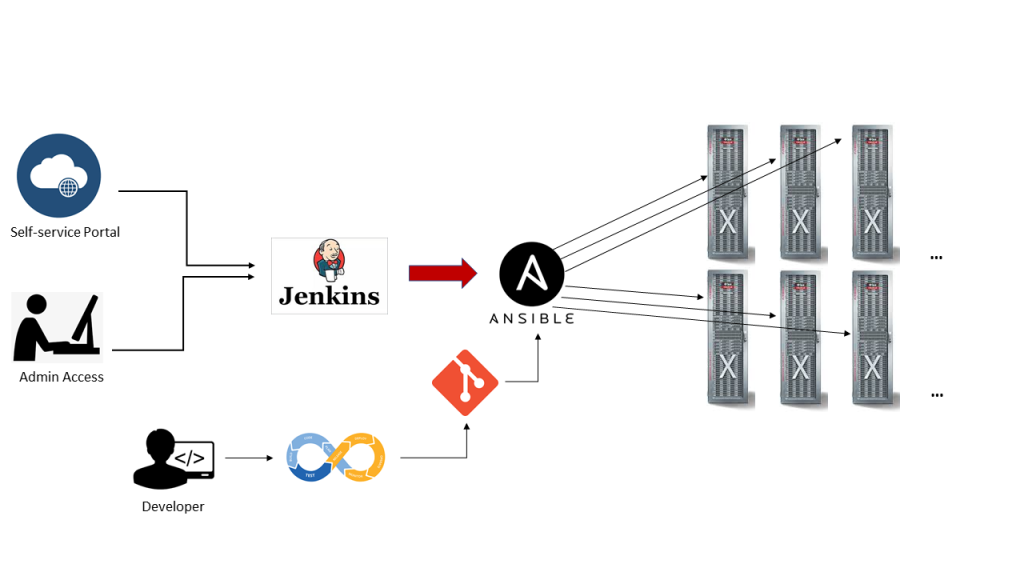#############################################################
## How to implement Oracle Resource Manager granting ##
## CONSUMER GROUPS to Clusterware services ##
#############################################################
--Create a service for OLTP sessions
srvctl add service -d dbrac10 -s DBRAC10_OLTP -r dbrac11,dbrac12,dbrac13
srvctl start service -d dbrac10 -s DBRAC10_OLTP
--Create a service for BATCH sessions
srvctl add service -d dbrac10 -s DBRAC10_BATCH -r dbrac11,dbrac12,dbrac13
srvctl start service -d dbrac10 -s DBRAC10_BATCH
###################################################################
## Resource Plan Design:
## MGMT_P1=75% SYS_GROUP, MGMT_P2=80% OLTP, MGMT_P2=10% BATCH, MGMT_P2=5%
## ORA$AUTOTASK_SUB_PLAN, MGMT_P2=5% ORA$DIAGNOSTICS, MGMT_P3=70% OTHER_GROUPS
###################################################################
## Resource Plan Implementation:
BEGIN
DBMS_RESOURCE_MANAGER.CREATE_PENDING_AREA();
DBMS_RESOURCE_MANAGER.CREATE_PLAN(PLAN => 'REAL_TIME_PLAN', COMMENT => 'Respurce Plan for OLTP database');
DBMS_RESOURCE_MANAGER.CREATE_CONSUMER_GROUP (CONSUMER_GROUP => 'OLTP',CATEGORY => 'INTERACTIVE', COMMENT => 'OLTP sessions');
DBMS_RESOURCE_MANAGER.CREATE_CONSUMER_GROUP (CONSUMER_GROUP => 'BATCH', CATEGORY => 'BATCH', COMMENT => 'BATCH sessions');
DBMS_RESOURCE_MANAGER.CREATE_PLAN_DIRECTIVE (PLAN => 'REAL_TIME_PLAN', GROUP_OR_SUBPLAN => 'OLTP', COMMENT => 'OLTP group', MGMT_P2 => 80);
DBMS_RESOURCE_MANAGER.CREATE_PLAN_DIRECTIVE (PLAN => 'REAL_TIME_PLAN', GROUP_OR_SUBPLAN => 'BATCH', COMMENT => 'BATCH group',
MGMT_P3 => 70, PARALLEL_DEGREE_LIMIT_P1 => 6, ACTIVE_SESS_POOL_P1 => 4, MAX_IDLE_TIME => 240);
DBMS_RESOURCE_MANAGER.CREATE_PLAN_DIRECTIVE (PLAN => 'REAL_TIME_PLAN', GROUP_OR_SUBPLAN => 'SYS_GROUP', COMMENT => 'SYS group', MGMT_P1 => 70);
DBMS_RESOURCE_MANAGER.CREATE_PLAN_DIRECTIVE (PLAN => 'REAL_TIME_PLAN', GROUP_OR_SUBPLAN => 'OTHER_GROUPS', COMMENT => 'OTHER group', MGMT_P4 => 50);
DBMS_RESOURCE_MANAGER.CREATE_PLAN_DIRECTIVE (PLAN => 'REAL_TIME_PLAN',GROUP_OR_SUBPLAN => 'ORA$AUTOTASK_SUB_PLAN', COMMENT => 'ORA$AUTOTASK_SUB_PLAN group', MGMT_P3 => 20);
DBMS_RESOURCE_MANAGER.CREATE_PLAN_DIRECTIVE (PLAN => 'REAL_TIME_PLAN', GROUP_OR_SUBPLAN => 'ORA$DIAGNOSTICS', COMMENT => 'ORA$DIAGNOSTICS group', MGMT_P3 => 10);
DBMS_RESOURCE_MANAGER.SET_CONSUMER_GROUP_MAPPING (DBMS_RESOURCE_MANAGER.SERVICE_NAME, 'DBRAC10_OLTP', 'OLTP');
DBMS_RESOURCE_MANAGER.SET_CONSUMER_GROUP_MAPPING(DBMS_RESOURCE_MANAGER.SERVICE_NAME, 'DBRAC10_BATCH', 'BATCH');
DBMS_RESOURCE_MANAGER.VALIDATE_PENDING_AREA();
DBMS_RESOURCE_MANAGER.SUBMIT_PENDING_AREA();
DBMS_RESOURCE_MANAGER.CLEAR_PENDING_AREA();
END;
/
###################################################################
## Grant the Switch to the Users
BEGIN
DBMS_RESOURCE_MANAGER.CREATE_PENDING_AREA();
dbms_resource_manager_privs.grant_switch_consumer_group ('PERF_TEST','OLTP',FALSE);
dbms_resource_manager_privs.grant_switch_consumer_group ('PERF_TEST','BATCH',FALSE);
DBMS_RESOURCE_MANAGER.VALIDATE_PENDING_AREA();
DBMS_RESOURCE_MANAGER.SUBMIT_PENDING_AREA();
DBMS_RESOURCE_MANAGER.CLEAR_PENDING_AREA();
END;
/
###################################################################
## Enable the Resource plan with the FORCE Option to avoid the Scheduler window to
## activate a different plan during the job execution.
ALTER SYSTEM SET RESOURCE_MANAGER_PLAN = 'FORCE:REAL_TIME_PLAN';
###################################################################
## Example of Group and Plan Deletion:
BEGIN
DBMS_RESOURCE_MANAGER.DELETE_PLAN (PLAN => 'REAL_TIME_PLAN');
END;
/
BEGIN
DBMS_RESOURCE_MANAGER.DELETE_CONSUMER_GROUP(CONSUMER_GROUP => 'OLTP');
END;
/
BEGIN
DBMS_RESOURCE_MANAGER.DELETE_CONSUMER_GROUP(CONSUMER_GROUP => 'BATCH');
END;
/
###################################################################
## SQL Queries for monitoring Resource Manager utilization:
###################################################################
## Check the service name used by each session
select inst_id, username, SERVICE_NAME, count(*) from gv$session
where SERVICE_NAME <>'SYS$BACKGROUND'
group by inst_id, username, SERVICE_NAME order by order by 2,3,1;
## List the Active Resource Consumer Groups:
select INST_ID, NAME, ACTIVE_SESSIONS, EXECUTION_WAITERS, REQUESTS,
CPU_WAIT_TIME, CPU_WAITS, CONSUMED_CPU_TIME, YIELDS, QUEUE_LENGTH,
ACTIVE_SESSION_LIMIT_HIT from gV$RSRC_CONSUMER_GROUP where name in
('SYS_GROUP','BATCH','OLTP','OTHER_GROUPS') order by 2,1;

